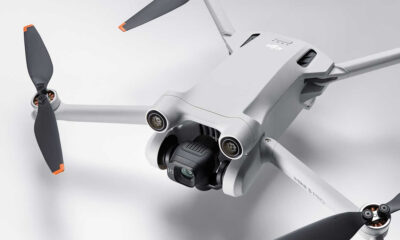News
DJI Releases The New $999 Air 2S Drone
Minor design and construction tweaks aside, there are 3 main upgrades that differentiate the DJI Air 2S from its predecessor, the Air 2.

The DJI Air 2 was one of the best drones released in 2020, offering everything most drone operators could ever want: a high-resolution camera, excellent battery life, tremendous range, and intelligent obstacle avoidance technology, just to name a few of its selling-points. Now, the Chinese drone powerhouse has released an updated version, calling it the DJI Air 2S.
Minor design and construction tweaks aside, there are three main upgrades that differentiate the DJI Air 2S from its predecessor:
- 1-inch CMOS sensor capable of recording 5.4K footage at 30 frames per second or 4K footage at 60 frames per second.
- Intelligent obstacle sensing in four directions that makes it possible for the drone to actively avoid obstacles in more complex scenarios and at high speeds.
- Advanced O3 (OcuSync 3.0) image transmission technology capable of delivering an ultra-smooth, clear, and reliable image feed at distances of up to 12 km.
These features alone make the DJI Air 2S a great all-rounder capable of recording professional-grade video footage, covering large distances, and providing aerial views, among other things.
Other noteworthy features include intelligent HDR technology capable of merging multiple shots, automatic hyperlapse and panorama creation, and MasterShots, an advanced intelligent feature that gives you the best shots in any location with just a tap.
Also Read: Sightec Completes First Drone Delivery Without GPS
The DJI Air 2S starts at $999, but the price jumps up to $1,299 if you purchase it two extra batteries, four ND filters, a charging hub, and a shoulder bag.

DJI Air 2S Fly More Combo
At this price point, it’s very difficult to find a more capable drone, especially if you’re a traveling videographer and want the best image quality in the smallest package. One possible alternative is the Skydio 2, a self-flying drone released in 2019 that records 4K footage at 60 FPS.
News
Alienware Just Announced Six New Gaming Monitors
The new models include three QD-OLED and three budget-friendly QHD options, expanding the company’s lineup for all gamers.

Alienware has just updated its gaming monitor lineup with six new additions, including the highly anticipated Alienware 27 4K QD-OLED Monitor. The latest wave of releases is set to reach more gamers than ever, offering high-end QD-OLED displays alongside more budget-friendly options.
The latest displays clearly show that the company is doubling down on QD-OLED with three new models sporting the technology. A redesigned Alienware 34 Ultra-Wide QD-OLED Monitor is also making a return, further refining what is already a fan-favorite display.
A Unified Design: The AW30 Aesthetic
All six monitors feature Alienware’s new AW30 design language, first introduced at CES. The AW30 aesthetic brings a futuristic, minimalist look that unites the entire lineup under a cohesive visual identity.
Pushing QD-OLED Even Further
The refreshed Alienware 34 Ultra-Wide QD-OLED Monitor (AW3425DW) builds on its predecessor’s success with a 240Hz refresh rate (up from 175Hz) and HDMI 2.1 FRL support. It also gains G-SYNC Compatible certification alongside AMD FreeSync Premium Pro and VESA AdaptiveSync, ensuring ultra-smooth performance. With a WQHD (3440×1440) resolution and an 1800R curve, this display enhances immersion for both gaming and cinematic experiences.
For those who crave speed, the Alienware 27 280Hz QD-OLED Monitor (AW2725D) pairs a high refresh rate with QHD resolution, balancing sharp visuals with ultra-smooth gameplay. Meanwhile, the Alienware 27 4K QD-OLED Monitor (AW2725Q) delivers stunning clarity with an industry-leading pixel density of 166 PPI, making it the sharpest OLED or QD-OLED monitor available.
Also Read: Infinite Reality Acquires Napster In $207 Million Deal
Worried about OLED burn-in? Alienware’s entire QD-OLED lineup comes with a three-year limited warranty covering burn-in concerns, offering peace of mind for gamers investing in these high-end displays.
Bringing QHD To A Wider Audience
Alongside QD-OLED, Alienware is also releasing three new QHD gaming monitors aimed at more price-conscious gamers. The Alienware 34 Gaming Monitor (AW3425DWM), Alienware 32 Gaming Monitor (AW3225DM), and Alienware 27 Gaming Monitor (AW2725DM) provide a range of sizes and formats to suit different preferences:
- The Alienware 34 Gaming Monitor (AW3425DWM): An ultrawide (WQHD) option for a panoramic, immersive experience.
- The Alienware 32 Gaming Monitor (AW3225DM): A standard 16:9 panel for a traditional but expansive desktop setup.
- The Alienware 27 Gaming Monitor (AW2725DM): A 27” display offering the same performance in a more compact form factor.
All three gaming monitors feature a fast 180 Hz refresh rate, a 1ms gray-to-gray response time, and support for NVIDIA G-SYNC, AMD FreeSync, and VESA AdaptiveSync to eliminate screen tearing. Additionally, with 95% DCI-P3 color coverage and VESA DisplayHDR400 certification, these displays deliver vibrant colors and high dynamic range for lifelike visuals.



























